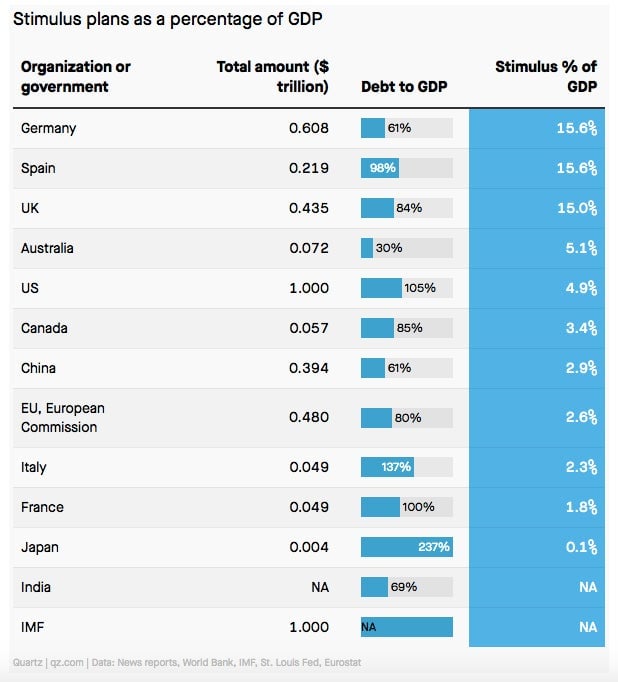Coronavirus: We’re gonna need a bigger bucket
Hello Quartz readers,

Hello Quartz readers,
Here’s what we’re eyeballing today:
- Africa’s largest city is trying to shut down.
- California and New York are staying indoors.
- Hospitalizations aren’t just hitting the elderly.
- ….Are we staying home for 18 months?
Cabin fever is setting in, so we definitely want to hear from you. Send your questions, thoughts, anxieties, and at-home workouts to [email protected]. Now let’s talk about bailouts.
A cure for what bails you
Governments around the world are preparing to lend and spend more than $3 trillion—a number that will almost certainly get bigger—to fight the coronavirus pandemic and keep their economies from falling off a cliff. Every society is going to have to decide how much to spend to save vulnerable people. Some will have to decide how close to push their nation to bankruptcy.
The US and Europe are preparing to throw around $1 trillion each at the problem, hoping to protect public health and prevent mass layoffs and corporate defaults. Central banks are cranking up emergency lending to keep companies on life support as a big chunk of global commerce comes to a standstill.
Some or even much of that money is likely to be in the form of loans and guarantees, and bailouts have gotten paid back (with interest) in the past. But there’s no denying these epic efforts are expensive, and they are just buying us time. How much time can be bought is an ethical question as much as an economic one.
“The costs of this national shutdown are growing by the hour, and we don’t mean federal spending. We mean a tsunami of economic destruction that will cause tens of millions to lose their jobs as commerce and production simply cease,” reads a March 19 editorial in The Wall Street Journal. “Think about the entrepreneur who has invested his life in his Memphis ribs joint only to see his customers vanish in a week. Or the retail chain of 30 stores that employs hundreds but sees no sales and must shut its doors. Or the recent graduate with $20,000 in student-loan debt—taken on with the encouragement of politicians—who finds herself laid off from her first job. Perhaps she can return home and live with her parents, but what if they’re laid off too? How do you measure the human cost of these crushed dreams, lives upended, or mental-health damage that result from the orders of federal and state governments?”
In many ways, the debate is repugnant—no society wants to weigh job losses against protecting human life. But it also has to be hashed out, if for no other reason than to counter the argument that a decimated global economy could have as much impact on life and livelihood as a wider or faster spread of the coronavirus. At a minimum, officials have to choke off enough public activity to keep the spreading virus from overwhelming health services. Everything else is up for grabs depending on a society’s priorities.
For all the gravity of these decisions, they are also happening at warp speed, and in silos that include government officials, but not average people who may well have to live with the results for generations. Depending on where you live, the measures being taken in your country, and your overall faith in government, that prospect can be as anxiety-inducing as the virus itself.
Quotable
“It’s hard to be effective at a time like this when the source of the problem is real. In 1933 when Roosevelt took office, he said there is ‘no plague of locusts,’ referring to the Depression. He was referring to a biblical story about a plague of locusts that came and destroyed a crop. There was no pandemic—no pandemic of insects or of viruses. But now there is. This is really different.”
—Nobel prize winning economist Robert Shiller
Go big or go big
Already, government bailouts are underway (we’re tracking them). Here’s how some major global economies are approaching the coronavirus fallout:
- United States: a stimulus package of around $1 trillion to aid the airline industry, small businesses, and individuals | cash handouts, potentially to the tune of $1,200 | deferred tax payments for some individuals and businesses | Small Business Administration grants | Fed interest rates slashed to near zero | emergency lending, including a financial-crisis-era facility for commercial paper
- Japan: a spending package of about $4 billion focused on small and mid-size companies | Bank of Japan will buy more than $100 billion worth of exchange-traded funds
- Germany: a package of at least €550 billion ($608 billion) | unlimited credit to keep businesses afloat
- Spain: as much as $219 billion in aid | prime minister Pedro Sanchez reportedly said private investment will provide €83 billion ($88 billion) of support
- UK: a bailout fund of £330 billion ($400 billion), announced March 17 | a plan—announced March 20—to pay 80% of wages for private-sector workers, up to £2,500 a month | small operators in retail, hospitality, and leisure will be eligible for cash grants of up to £25,000 | a three-month mortgage holiday for homeowners in financial difficulty because of the pandemic | The Bank of England cut its target rate by 0.5 percentage point to 0.1% on March 19
- France: €45 billion ($48 billion) to help small businesses and employees | president Emmanuel Macron said there will be unlimited aid for businesses
- Italy: €25 billion ($49 billion) of support for companies and workers
- India: The government is reportedly pushing its banks to approve as much as 600 billion rupees ($8.1 billion) of loans by the end of March | The Reserve Bank of India announced long-term repo operations (LTRO) to reduce interest rates and boost lending.
- Canada: The government is planning a package totaling C$82 billion ($56.7 billion), which includes C$27 billion of support for individuals and companies | The Bank of Canada cut its overnight interest rate by 50 basis points to 0.75% on March 13.
What about China?
At first glance, China’s stimulus efforts seem moderate relative to the size of its economy and the severity of the virus’s impact there. That’s because in China, state-owned enterprises are on the front line against economic fallout. President Xi Jinping ordered these companies to step up “unconditionally, and at any cost,” according to the Wall Street Journal. Banks are doling out cheap loans, while utilities reduce electrical bills. The government is also planning around $394 billion of infrastructure spending, according to Reuters, backed by local government bonds.

American airlines
Airlines are in trouble as global transportation grinds to a halt. Should the US government rescue them? If so, how… and when?
The response to the 2008 financial crisis featured two major bailouts. One helped banks, the other automakers. The failure of such companies, lawmakers reasoned, would spread through entire systems.
By contrast, “there is no systemic risk from bankruptcies in airlines or hotel chains,” says Adam Posen, president of the Peterson Institute for International Economics. “[With] the airline industry, we should only be concerned…with respect to their employees and their contractors, not their shareholders, or their planes, or their management. There is overcapacity in this industry.”
If airlines go bankrupt, they can fly limited routes in receivership, but rescuing them with public money won’t put passengers back in seats.
“We should take the lesson from what we should have done in the banking crisis,” Posen says. “If you are going to bail them out, wipe out shareholders. Or give the government, on behalf of the American people, some stake in the upside, [and] massively restrict payouts and dividends in the future.”
Weapons of mass description
Nothing works better in a crisis than a metaphor. Here are a few ways the language of war and weaponry is finding its way into bailout discussions.
- Bazooka: The “big gun” universally invoked to describe an extreme economic stimulus move by a central bank. The Fed shot its bazooka, as did the ECB.
- War: US president Donald Trump called is calling coronavirus a “medical war” that has to be won.
- Reload our weapons: What Germany’s economy minister said the country would be willing to do if its current stimulus plan (the biggest since World War II) isn’t enough.
- Water pistol: What Project Syndicate says Germany’s plan more closely resembles.
- Martial law: This one’s no metaphor, and it’s already a reality in some countries. The idea is so unheard of in the US that “Marshall Law” was trending after Republican senator Marc Rubio misspelled it in a tweet.
Too soon?
While there is growing consensus that a direct-to-citizen relief plan—also known as helicopter money—is needed to stem the fallout from coronavirus, not everyone agrees that now is the time to do it. Frances Coppola, author of the Coppola Comment finance and economics blog, argues that it’s too early to start dropping cash from the sky. “If helicopter money is used at the wrong time and for the wrong purpose,” she writes, “there is a real risk that it won’t work and will then be dismissed as useless.”
Coppola says the amounts being discussed are too small to replace wages, and could be counterproductive when people are self-isolating. She argues that it “would be far better to break out the helicopters when the virus has passed and people start emerging from their cocoons.”

Essential reading
- The latest 🌏 figures: 265,495 confirmed cases; 87,363 classified as “recovered.”
- Word War III: China is winning the coronavirus propaganda battle.
- OK Zoomer: Classes, convos, and celebrations are going down via videoconference.
- I feel so seen: How China built facial recognition for people wearing masks.
- Cornered: London’s corner shops are becoming vitally important again.
- Missed connection: The coronavirus crisis is showing us how to live online.
- Coolcoolcool: We’re not going back to normal.
Our best wishes for a healthy day. Get in touch with us at [email protected], and live your best Quartz life by downloading our app and becoming a member. Today’s newsletter was brought to you by John Detrixhe, Tim Fernholz, Susan Howson, and Kira Bindrim.